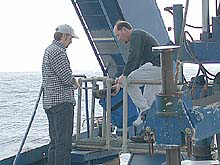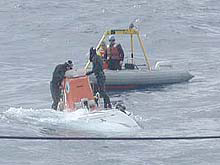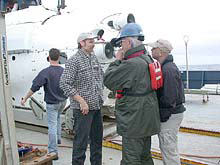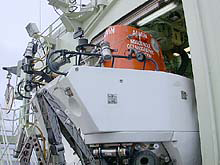Calm Seas Result in a Successful First Dive
June 26, 2002
Catalina Martinez
NOAA Office of Ocean Exploration
Alvin Launch
DIVE 1
Murray Seamount
Location: 53.90N, 148.50W
Mother Nature cooperated with us today and provided relatively calm seas for our first Alvin dive of the expedition. After experiencing low-pressure systems for three days that resulted in heavy seas and a relentless wind, we were pleasantly surprised (to say the least) at the calm conditions of the morning.
Alvin began the slow transit out of the hanger at approximately 7:15 am, and all hands were on deck in anticipation of the first launch sequence of the expedition. Bruce Strickrott, one of three Alvin pilots on board, entered the sub, followed by Brad Stevens, a NOAA Fisheries scientist from Kodiak, AK, and Randy Keller, a marine geologist from Oregon State University.

Randy Keller and Brad Stevens (from left to right) entering Alvin on our first dive. Click image for larger view.
Alvin is launched and recovered with an A-frame that lifts the sub off the deck, moves it out and away from the ship, and then places it in the sea. "Swimmers" are present to detach and attach lines from the A-frame to the sub (among other duties) during the launch and recovery processes. A small boat called an Avon stands by to pick up the swimmers and to deal with any last-minute details. Once the swimmers secure the hatch on the Alvin, the sub begins to descend to a predetermined depth.

Swimmers Brian Leach and Anthony Berry, speak with the Alvin pilot during the first launch while Kevin Threadgold and Ed “Catfish” Popowitz stand by in the Avon. Click image for larger view.
Sub to Surface Communication
Contact with the sub is maintained throughout the entire dive by a surface controller (typically one of the Alvin pilots) who also provides surface navigation for the Alvin. The Alvin pilot calls up at least once every half hour to state the latitude and longitude of the sub, and to provide other pertinent information. If communication is cut off for one sequential hour, then the Alvin pilot will begin to surface as a safety precaution. The sub must be back at the surface no later than 5:00 pm, and a dive can last pretty much as long as the power on the sub lasts. This is dependent on many things, such as the maximum depth of the dive, the strength of the current, and how much light is used during a dive.
Alvin Recovery Operation

Randy Keller being interviewed by Chad Cohen, producer for the National Geographic Channel, while Norris Brock, videographer for the National Geographic Channel, records the moment. Click image for larger view.
The Avon is launched for the recovery operation just prior to the projected surface time of the Alvin, and swimmers provide navigational instruction to the sub pilot while at the surface. Recovery is a much longer process than the launch. It can be a difficult and dangerous operation if the seas do not cooperate. The sub provides a ride often described as a “washing machine-effect” while at the surface, so all are eager to get out as soon as possible. Some are greener than others!
At the end of the first successful dive of the expedition, the science crew swarmed the passengers, eager to learn what was discovered on Murray Seamount. Amidst the flashes of cameras (the largest of which was carried by Norris Brock, videographer for the National Geographic Channel), stories and the excitement of discovery were shared by all.
Sign up for the Ocean Explorer E-mail Update List.



























